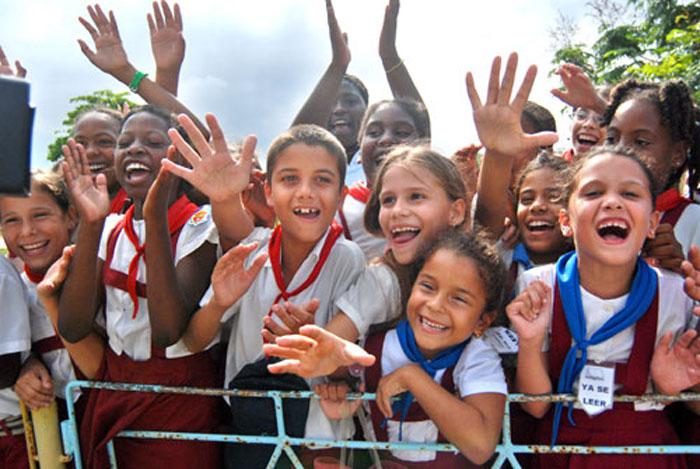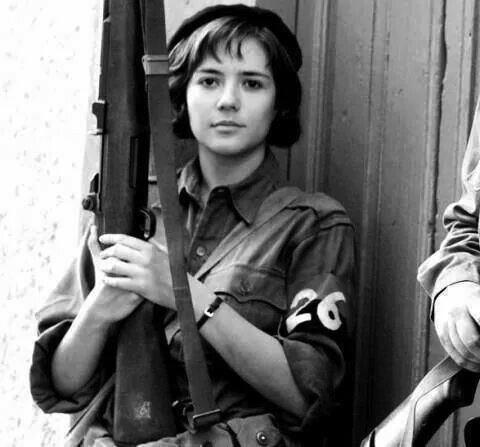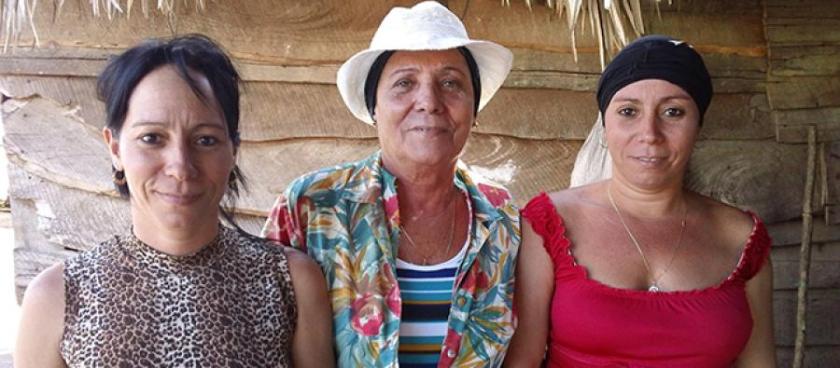While Cuba has been suffering material insufficiency brought about primarily by the US-enforced economic blockade, Cuban women, especially mothers, enjoy the kind of protection not very much known in the Philippines.
By Melissa Gracia Lanuza
Every time I talk to Kat, Dunia or Juling, women neighbors who almost always grumble about problems on child delivery, sending children to school, violence of their husbands and taking care of themselves and of their old and sickly parents-in-law, I could not help but wish that Filipinas get to enjoy as well the care Cuban women are getting. The Cuban government and society, take care of their women (and all the people) in their country from childhood until their years as grandmothers. Upon deeper reflection, though, I doubt if it could be possible to replicate this in the Philippines now given that this care for women in Cuba is part and parcel of emancipating women, an agenda of their socialist revolution.

Happy children in one school event in Cuba. The Cuban govenment ensures the welfare of children through a program that provides enough benefits to thier parents from their birth until they enter school. granma
Free and high-quality education
Immediately after Fidel Castro and the July 26 movement overthrew the Batista dictatorship on January 1, 1959, the new government launched a literacy movement. It was primarily the women that benefitted from this as traditionally, more women than men did not get higher education not only because of poverty but also because education of girls was not a priority for many families. Since the literacy campaign, the government have continuously improved Cuba’s educational system. Education from pre-school to college and even beyond is free and the government gives free breakfast, lunch and snacks to all students.
For the socialist government, education is so important that even during the “special period,” when the Soviet Union, amidst its impending collapse, stopped giving subsidy to Cuba while US pressure on Cuba to abandon its socialist agenda was unremitting, education was still free and students still received free food.
Cuban women’s education has gone a long way since then. The UNESCO declared Cuba in 1961 as the first country in the whole world without illiteracy. And, while only 3% of the college graduates in 1959 were women, presently, 58% of the college graduates and 62% of those enrolled in the collegiate level are women.
Healthcare
The government and society prioritize healthcare, especially that of women. With the help of the Federation of Cuban Women (FMC, the Spanish initials), they have set up institutions that assist families by ensuring education drives and disease prevention, and attend to squabbles, domestic violence and other problems that may need legal aid.
The government guarantees comprehensive women’s healthcare as it implements universal healthcare programs for families. Hence, no woman or infant is not covered by the country’s mother and infant healthcare program. They have tests for cervical, uterine and breast cancer. They have support for the aging and the truly aged women. They have programs on sexually transmitted diseases including HIV and AIDS.
Among the most prominent achievements in health care are the very low infant mortality rate (4 for every 1,000 live births) and maternal mortality rate every year and the elimination of the mother-to-child transmission of HIV and syphilis. For the latter, Cuba got the World Health Organization’s recognition.
Support for motherhood
The 2003 Decree-Law 234 on maternity leave with a Complementary Resolution Number 22/2003 has given women and men maternity/paternity leave during the first year of the infant, designed to change the traditional role of women and men in the family and emphasize sharing responsibilities in caring for children.
This was improved in 2017. Law 339, on Maternity of Women Workers and Law 340, Modification of Special Security Regimes are protections related to birthing passed on December 8, 2016 but took effect on February 10, 2017.
Both are among the laws that carry out a policy in response to the situation that, for varied reasons, many women do not want to have more than one child and Cuba now has an aging population. Both are among the comprehensive policies in the process of perfecting and updating their socialist economy.
Law 339 has four outstanding provisions.
First, monetary maternity benefits should not be lower than the minimum wage implemented in Cuba.
Second, women that have more than one employment will receive commensurate monetary maternity benefits in accordance with the length of period they have worked, for as long as they have complied with the requisites of the law. With this, a working mother of this type will receive more monetary maternity benefits.
Third, in the case of women with fixed term contracts of more than one year, they have the right to monetary benefits for prenatal and postnatal leave once they reach the 34th week of pregnancy provided that it’s not yet three months since their contracts lapsed.
And fourth, the right to social security benefit extends to working grandfathers or grandmothers, whether on the side of the father or the mother, instead of being limited for the mother and father only. This means, if the grandfather or grandmother or the father (that is covered by the older law) decides to take care of the child after the post-natal leave of the mother (in order for her to return to work) until the child turns one year old, he or she will receive social benefit equivalent to 60% of his or her average monthly salary that is computed based on the immediate 12 months before the birth of the child.
Another nice thing about this is, if the relative attending to the child does not claim the social benefit, the mother (who has gone back to work within the social benefit period or after the post-natal leave and before the first birthday of the child) has the right to receive both her salary and the social benefit.
Meanwhile, the parliament passed Law 340 so that women workers registered under special schemes can receive monetary benefits. Self-employed women, those in creative arts, artisans and usufructuary holders of agricultural lands belong to the special regimes.
In the older law, for a woman to receive monetary maternity benefit, she should have paid her social security contributions for at least 12 months. With the new law, the requisites for women workers in special regimes to qualify for monetary benefits have been revised.
According to the law, to be counted in the contribution period are the periods when the worker was exempted from paying for her social security because of illness or because she was on maternity for a previous pregnancy. This means, she is required to pay a smaller monthly contribution only and she will be qualified for the minimum requisite to receive monetary maternity benefit. Social Security benefits, however, will vary under every regime.
Over and beyond the right to maternity leave with pay, the right to unpaid leave is extended to other members of the family aside from the mother and father. Under the law, when the child has reached one year, the one primarily attending to the child, be he or she the mother, father, grandfather, grandmother, uncle or aunt, may still take a leave for three months. This leave, though, is without pay.

Aleida March, active in Cuba’s revolutionary war, the wife of Che Guevara. They have four children. Photo taken, 1959. breads and roses
A result of the struggle
The pioneers of the Cuban revolution held that women’s emancipation is an essential part of the socialist revolution. It did not mean, though, that the rights and protection were instantly in place even without them pushing or working for these.
Celia Sanchez, Melba Hernandez, Haydee Santamaria and Vilma Espin, women who composed the Mariana Grajales Front in Sierra Maestra, were among those who fought for the freedom of their people and cleared the road for the struggle for women’s emancipation. They were women who were culturally ahead of their time.
Patriarchy prevailed in Cuba before the revolution. According to Alejandra Garcia’s article in Granma on March 7, 2018:
“In the 1950’s women were at best nothing more than objects or decorations. Society had accepted and tolerated male dominance over and subjugation of women, who were then largely confined to the domestic sphere. Women did not even have the right to apply for many types of employment that were then considered as suitable solely for men. Those fortunate enough to get jobs, were, under the law, forced to accept salaries lower than those given to men occupying the very same positions.
“Patriarchy manifested itself with equal crudeness and severity, both visible and invisible. Women had to endure insults, verbal abuse, threats, rape, and even murder—all for everyone to see. Less visible however were the scorn, emotional blackmail, sexist language, sexist humor, and sexist publications—including those wherein women wear scanty clothes to advertise products—and a host of other incidents and situations wherein women were degraded and undervalued. Women were the majority of those who were illiterate, as illiteracy at that time inflicted an intolerably high percentage of the population. Their role in the political life of the nation was negligible.”[i]
And so, when the FMC was established under Vilma Espin’s leadership, Fidel Castro challenged it to forge ahead “until the last vestiges of discrimination of the Cuban woman is erased and achieve, with her ability and merit, her appropriate place in history.”
Thus, the FMC served as space for the Cuban women for organized petitions, cooperation and for finding other spaces to develop and empower women.
The FMC actively conducted education work among women and involved them in different fields of endeavor. This is why, according to the article, Cuban Women: A Revolution within a Revolution, March 9, 2018, 48% of the labor force in the state sector are women. Those in management positions compose almost the same percentage. For every 10 lawyers, eight are women. In the national assembly, 8.86% of the deputies are women. This translates into important contributions of women in forming policies to improve the socialist system.

Women farmers of Cuba.oxfam
Seventy-eight-point five percent (78.5%) of the health professionals and almost half of those doing scientific research are women. Women compose 66% of the highly trained technicians and professionals and earn the same amount as the men in the same positions.
The FMC at present has four million members, 90.6% of the women and girls past 14 years old, the minimum age requirement for membership.
Continuing challenge in building socialism and emancipating women
Fidel acknowledged the revolutionary women’s role in the Cuban struggle.
“Without women, the enormous work of the Revolution would not have been possible. Throughout these difficult years, there has been no economic, social or political task, there has been no scientific, cultural or sporting achievement, there has been no contribution to the defense of our land and the sovereignty of the Homeland, which has not relied on the invariably enthusiastic and patriotic presence of the Cuban woman. No one like her has made the greatest sacrifices in the special period (…) nor risen up such that her everyday effort becomes a feat.”
Much have to be done, though. Even on the issue of caring for women, for instance, more specific gender-based programs like one to respond to women’s stress and fatigue as they perform dual loads of working for a living and household management.
Unfair social prejudices, old stereotype thinking and macho mentality still exist. For example, while laws allow paternity leave, not all fathers avail of this. They still have to enhance men’s active participation in child care.
Women’s response to the state’s call to have at least two children is slow. Cuban authorities consider their still poor housing facilities as one of the reasons, and this problem is related to the general state of Cuban production and economy.
Undeniably, even if we fervently desire it, women’s emancipation cannot be achieved merely through discussions, debates and calls. This is closely linked to and an essential part of society’s development.
But for me, and on behalf of Kat, Dunia, Juling and my other women neighbors, the situation of Cuban women is already something to die for, out of envy. K
[i] This is a liberal translation of two paragraphs from the original article published in Spanish. [1] Robert M. Corpuz and Herbert Mir Baguisa, Filipinos who studied medicine iin Cuba as scholars confirm this. [1] Cuba gives women workers monetary maternity benefits for 18 months or more than four months. (This is what they call, maternity leave with pay.) When a wwoman reaches the 34th week of pregnancy, or the 32nd week if the woman is ccarrying more than one fetus, she has the right to maternity leave with pay ffor six weeks before delivery and 12 weeks after delivery. It gives the wwoman her social security benefit for the period after the maternity leave wwith pay until the child’s first birthday. The mother may decide to receive tthe social benefit herself or to let another working member of the family aattend to the child and receive social security benefit. [1] A usufructuary is a holder of a usufruct who has the right to use the pproperty and enjoy its fruits. A usufruct is a limited real right according tto civil law. It is a combination of two interests on a property: the right tto use and the right to enjoy the fruits or income from the property such as, by selling crops, renting out immovables or by collecting fees from people or vehicles that enter the property. The holder of a usufruct has limited right s and these rights usually end during his death. (He or she cannot pass it to his/her sons or daughters as inheritance. [1] This is a liberal translation of two paragraphs from the original article published in Spanish.

